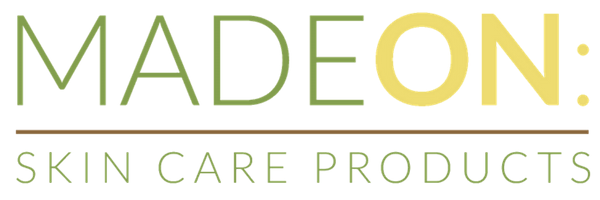An ingredient on the container of Desitin near my baby’s changing area read in bold letters: 40% Zinc Oxide. Could the rash-fighting ingredient in my store-bought rash cream simply be zinc oxide? I was fairly confident zinc oxide was safe since I saw it in several other natural skin care recipes, but it would be expected of me to do my research before producing and selling a new product, and so I did.
Here are the steps I take when determining which ingredients I use for MadeOn products and recipes:
1. Does it do the job I need it to do? If zinc oxide can’t fix a rash or protect the skin from sunburn, if iron oxide can’t color a lip balm, if citronella can’t repel mosquitoes, what’s the use? This is the most important step: the ingredient must be effective.
2. Does the FDA allow it in cosmetics? For selling purposes, I obviously have to follow the law. I found that while cocoa powder does color lip balm as well as lips, the FDA does not approve it as a colorant, so I can’t sell a lip balm tinted with cocoa powder. The FDA does allow ingredients that I personally wouldn’t use, so I don’t stop here….
3. Is the ingredient approved by the FDA in the U.S., but banned in other countries? This is easier said than done, but I will use keywords similar to the language in this article to do my search: 12 cosmetic ingredients legal in the U.S. but banned elsewhere.
4. What rating does the Environmental Working Group’s Skin Deep Cosmetics Database give the ingredient? If you haven’t checked it out, this database is an amazing resource of products and ingredients with a “safety rating” (0 is the safest rating). As not every ingredient listed has extensive research done with it, EWG also notes how much data is available with each ingredient, as well as links to various articles proving the research that’s been done.
5. Is the ingredient edible? While I won’t rule out an ingredient if it’s safe in every other way except consumption, I prefer that it be so safe, that having your toddler take a bite out of it won’t harm the child.
6. Is it a common allergen? Everything appears to be an allergen to someone in the world, but I avoid the obvious ones (peanut oil, fragrance oils, wheat germ oil AKA vitamin e). Unfortunately, those who are allergic to tree nuts may likely be allergic to shea butter, but this one I’m pretty passionate about including in my products, so it’s in.
7. What does Wikipedia say? While the popular online encyclopedia isn’t the final answer to every question, it does link to well-researched documentation that gives me confidence in understanding the ingredient and its benefits as well as potential controversies.
8. What do other skin experts say? There are some investigative bloggers who do a wonderful job of researching ingredients and recipes, testing them, and reporting back to their readers, while keeping up with the hundreds of comments and feedback left on their blogs. Two are Katie from Wellness Mama and Leslie from Crunchy Betty.
9. What do particular Facebook groups say? Choose carefully, or it will feel like the blind leading the blind, but overall, I’ve found a few private Facebook groups that do a good job of sharing information, run by a moderator or two who really know their facts. Why are they kept private? Like any group who wants to keep like-minded members together, you need to sift out the trouble makers (a.k.a. friends of the members who see the posts in their feeds, and are quick to critique your healthy lifestyle choices).
10. What do my readers and customers say? If the ingredient can pass the above nine steps, I’ll use it in a recipe or product, and eventually I will be contacted by someone questioning my choice. Sometimes it’s misinformation that I can help them with (“Oxide? Is that a chemical??”), sometimes it’s clarification on something they’ve read in the news (“Do you use nanoparticles?”) and sometimes it’s new research that I haven’t come across that requires my attention (“Is the coconut oil you use bleached with actual bleach?” Answer: no).
In the end, I’m very glad we’ve been able to come up with recipes that are made with as few ingredients as necessary to get the job done. As for the zinc oxide in my Simply Soothing rash cream and sunscreen recipe, I’ve blogged about that here: https://hardlotion.com/2012628can-we-trust-zinc-oxide-html/
